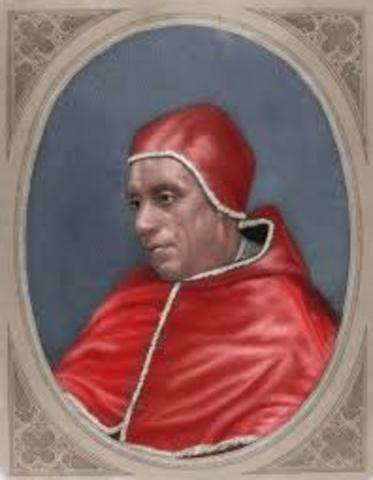
If you think following the story of Avignon and the Western Schism has been difficult, sit down. The papacy under Gregory XII is even more confusing.
Angelo Corrario, the future Pope Gregory XII, was born somewhere between 1325 and 1335, of a prominent Venetian family. He achieved a master’s degree in theology and went on to teach that subject at the University of Bologna. He became the Bishop of Castello in 1380, then, the titular Patriarch of Constantinople in 1390. After Innocent VI was elected, Corrario became cardinal priest of San Marco. When Innocent died in 1406, Corrario was at the conclave.
At this conclave, each Roman Cardinal (as opposed to the Avignon Cardinals) took an oath that if elected, he would resign, if Avignon Pope Benedict XIII would agree to. The goal would be to reunite with Avignon. Since Cardinal Corrario was renowned for his dedication to the Church’s unity, he was elected unanimously on Nov. 30, 1406. He took the name Gregory XII.
Gregory’s Pontificate
Two weeks later, Gregory notified Benedict of his election. He added that he would abdicate if Benedict did the same. The Avignon pope sent word that he agreed and suggested the two meet at Savona. They did not meet. It was assumed that Benedict did not really want to abdicate. Gregory’s very vocal family were reluctant to agree to the meeting. King Ladislaus of Naples played on Gregory’s fears of Benedict’s real intent.
In a short time, the Roman cardinals started to mistrust Gregory’s desire to stop the Western Schism. In May, 1408, the pope convened the Roman cardinals at Lucca then he left. They contacted some of Benedict’s cardinals and jointly held a council at Pisa to discuss reunification. The cardinals summoned both Benedict and Gregory. Neither showed. In June, 1409, the cardinals declared both popes to be deposed. They elected a new pope, who took the name Alexander V. Meanwhile, Gregory opened his own synod and condemned both Benedict and Alexander. Strangely, most Catholics seemed to support either Benedict or Alexander. Only the German kings, Naples and a few others supported Gregory.
Louis II of Anjou, a thorn in the side of King Ladislaus, restarted his war and took several Papal States. By 1410, he took Rome. Then he declared Alexander as the true pope. As fate would have it, Alexander died by May. The new pope, elected by the Pisan cardinals, was John XXIII.
King Rupert of Germany died, in May also. He had supported Gregory. Rulers of the German states wrote to Louis II, informing him that they would support Sigismund of Hungary in Rupert’s stead. A heroic figure, Sigismund supported John XXIII. Gregory lost so much support that he went to live with his friend Carlo Maletesta, in Rimini.
Pope John had been a soldier before he was a cleric. He supported Louis II of Anjou against Ladislaus in their perpetual war for the kingdom of Naples. Ladislaus won a large battle in May 1412 and Louis went back to France to regroup. So, John switched allegiances and offered benefits and protection to Ladislaus. Ladislaus then turned on Gregory. In this odd cycle, Ladislaus seized Rome a year later, making an enemy of John, who, then, supported Sigismund.
Sigismund, who had been given the title of Standard Bearer of Christendom, when he was crowned, chose to take his title seriously. In 1413, he invited both Gregory and Benedict to a General Council at Constance to take place the following year. Then, he ordered John to officially convoke the council, since he seemed to have the largest number of followers.
By this time, Ladislaus had died and John had gotten Rome back. “Pope” John and his nine Roman cardinals got to Constance in time to open the council. Emperor Sigismund controlled the proceedings, announcing that all three popes should abdicate. John ran off but was forced to return. He abdicated at session 12 of the council. Gregory sent Maletesta and Cardinal Domenici of Ragussa as his representatives. Maletesta read Gregory’s abdication letter. Benedict did not show. Gregory retired. In September of 1415, Sigismund tried to get Benedict to abdicate. He refused. Two months later, his remaining supporters refused obedience. Benedict was a pope in name only.
Two years later, before a new pope was elected, Gregory died on October 18, 1417. The Western Schism was through.
External link: POPE GREGORY XII, THE END OF THE WESTERN SCHISM (catholic365.com)
Internal link: POPE INNOCENT VII, ATTEMPTING TO END THE WESTERN SCHISM – Lanternarius Press

Recent Comments